House of Wittelsbach
![]()
This article is about the noble house. For other meanings, see Wittelsbach (disambiguation).
The House of Wittelsbach is one of the oldest German high noble families, named after its ancestral seat in the 12th century, Wittelsbach Castle. For centuries it produced the Palatines, later Dukes, Electors and Kings of Bavaria (1180-1918), as well as the Palatines of the Rhine (1214-1803 and 1816-1918), who as rulers of the Electoral Palatinate were Electors of the Holy Roman Empire.
Two Wittelsbachers were elected Roman-German emperors (1328 and 1742) and one Roman-German king (1400). Other territories of the Holy Roman Empire that were temporarily ruled by members of the house were the Electorate of Cologne (1583-1761), the Duchy of Jülich-Berg (1614-1794/1806), the High See of Liège, the Margraviate of Brandenburg (1323-1373), the Counties of Tyrol (1342-1363/1369) and Holland, Hainault and Zeeland (1345-1432), and the Duchy of Bremen-Verden (1654-1719). Twice, in 1619 and 1742, Wittelsbach were counter-king in Bohemia.
As one of the most important dynasties in Europe, they also temporarily provided the kings of Hungary (1305), Sweden (1441-1448 and 1654-1720), Denmark and Norway (1440), and Greece (1832-1862). The Wittelsbach princess Sophie of the Palatinate, a Stuart on her mother's side, became heiress to the English throne by the Act of Settlement of 1701, and to the British throne from 1707.
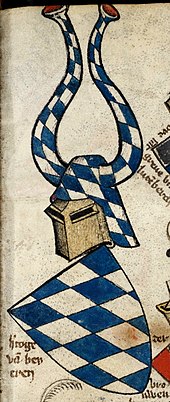
Coat of arms of the Dukes of Bavaria in the Armorial Gelre, 1369-1414
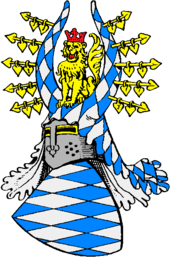
Coat of arms of the Counts of Bogen, from 1242 of the Bavarian Dukes from the House of Wittelsbach (around 1300)

Coat of arms of the Palgraves near Rhine by Otto Hupp in the Munich Calendar of 1903
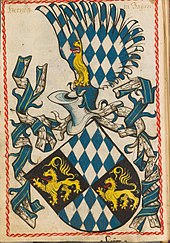
Geviertes Wappen Bayern-Pfalz, Scheiblersches Wappenbuch 1450-1480
Source
The exact origin of the Wittelsbach is unclear. The theory that is most widely accepted today, even by members of the Wittelsbach family and many scholars, is based on the genealogy of Otto Freiherr von Dungern, published in Austria in 1931, in which the history of the family begins around the year 1000 with a Count Otto I of Scheyern, who is named in documents as Otto comes de Skyrum. Starting with his son, Otto II of Scheyern, the secure history and lineage of the Wittelsbach family begins.
Thesis of the Luitpoldingers as origin of the Wittelsbacher
Numerous legends and theories surround the origins of the Wittelsbach dynasty. Courtly authors of the Renaissance period, as with other dynasties, liked to create legendary origins, which usually referred back to Charlemagne or to heroes from Homer's ancient Troy.
A rather speculative thesis of the historian Karl Bosl states that the Wittelsbachers descended from a side line of the Luitpoldings, named after Margrave Luitpold of Bavaria († 907). Luitpold's son, Arnulf the Wicked, was elected German (counter-)king in 919, but eventually submitted to Henry of Saxony and contented himself with the duchy of Bavaria. After Arnulf's death in 937, his eldest son Eberhard was deposed in 938 by King Otto I , the Great, and Arnulf's brother Berthold was appointed duke. Arnulf's younger son, Arnulf II, was given the newly created office of Count Palatine of Bavaria, a position subordinate to the duke. Emperor Otto I married his brother Henry to Arnulf's daughter Judith, which allowed Henry to succeed Berthold as Duke of Bavaria after Berthold's death in 947, bypassing Berthold's son. Thus the Liudolfingers (also called Ottonians) had displaced the Luitpoldingers.
According to Bosl, Count Palatine Arnulf II is said to have built Scheyern Castle in 940, but this cannot be proven. He had a son Berthold von Reisensburg, from whom, however, no direct line leads to the later Counts of Scheyern. Otto I of Scheyern, who first appeared in 1045 and soon became bailiff of the Freising diocese, is the oldest clearly provable ancestor of the Wittelsbach dynasty. It was not until 1116 that his grandson Otto V of Scheyern received the Palatine earldom in Bavaria. The representatives of the Luitpoldinger thesis fill the gap of about 150 years between the birth of Berthold of Reisensburg and Otto I of Scheyern partly with the Margrave Berthold of Schweinfurt and his son Heinrich, although the origin of the Schweinfurters is also unclear. Berthold is seen as a close relative of the Babenbergs; his son Heinrich of Schweinfurt is said to have been a cousin of the Austrian Margrave Luitpold I and to have had a younger son Heinrich I, Count on the Pegnitz and of Weissenburg († 1043), who according to this thesis is in turn said to have been the father of Otto I of Scheyern.
The early Wittelsbachs until 1253
The Counts of Scheyern, Palatine Counts of Bavaria and first Dukes of Bavaria with their collateral lines
The counts of Scheyern were:
- Otto I of Scheyern (* c. 1020; † 1073), ∞ (I) sister of Count Meginhard of Reichersbeuern, ∞ (II) widowed Countess Haziga.
- Otto II of Scheyern (*?; † 1120), ∞ Richgardis of Istria-Crain from the house of Weimar-Orlamünde, daughter of Margrave Ulrich I (widow of his brother Ekkehard I).
- Otto III of Scheyern († c. 1130)
- Ekkehard III of Scheyern († around 1183)
- Bernhard II. of Scheyern, canon in Freising († around 1135)
- Bernhard I. von Scheyern, Benedictine, founder of the monastery Fischbachau, prior of the monastery Tegernsee, bailiff of the diocese Freising and the monastery Weihenstephan, from 1096 count of Scheyern
- Ekkehard I of Scheyern (*?; † after 1101), ∞ Richgardis of Istria-Crain from the house of Weimar-Orlamünde.
- Otto V. of Scheyern (* ?; † 1156), since 1116 Count Palatine of Bavaria, moved the residence of the Count Palatines from Scheyern Castle to Wittelsbach Castle in 1124, ∞ Heilika von Lengenfeld
- Otto VI of Scheyern-Wittelsbach (c. 1117-1183), Count Palatine of Bavaria, from 1180 as Otto I Duke of Bavaria, ∞ Countess Agnes of Loon.
- Ludwig I, the Kelheim (1173-1231), since 1183 Duke of Bavaria and from 1214 Count Palatine of the Rhine, ∞ Ludmilla of Bohemia, widow of Count Adalbert III of Bogen.
- Otto II. , the Illustrious (1206-1253), Duke of Bavaria and Count Palatine on the Rhine, from 1251 Imperial Governor, ∞ Agnes of the Palatinate († 1267), daughter of the Guelph Henry of Brunswick and the Staufer Agnes, Count Palatine on the Rhine.
- Louis II, the Austere (1229-1294), since the division of the land of 1255 Duke of Upper Bavaria and Count Palatine of the Rhine; ⚭ I) Mary of Brabant, ⚭ II) Anne of Glogau, ⚭ III) Matilda of Habsburg → ancestral list of the House of Wittelsbach.
- Henry XIII (1235-1290); since 1255 Duke of Lower Bavaria; ⚭ 1244 Elizabeth of Hungary → ancestral list of the House of Wittelsbach.
- Otto VII of Wittelsbach, Count Palatine of Bavaria († 1189)
- Otto VIII of Wittelsbach, Count Palatine of Bavaria († 1189)
- Konrad von Wittelsbach (ca. 1120/1125-1200), Archbishop of Mainz and Salzburg
- Arnold I of Scheyern († c. 1123), first count of Dachau in 1104, ∞ Beatrix of Reipersberg († 1124), heiress daughter of the county of Dachau; they built Dachau Castle c. 1100.
- Conrad I of Dachau († c. 1130)
- Konrad II. of Dachau († 1159), from 1152 Duke of Merania (first holder of the ducal dignity)
- Conrad III of Dachau († 8 October 1180/82), second duke of Merania (succeeded by Otto I of Wittelsbach, from 1180 duke of Bavaria)
- Arnold III of Dachau (* c. 1122; † 1185)
- Arnold II of Dachau († c. 1124)
- Frederick I of Dachau († c. 1124)
- Otto I. of Dachau-Valley († c. 1130; founder of the Counts of Valley, died out in 1268)
The bearers of the name Otto who are missing in the count of the counts of Scheyern fall to the side lines of the counts of Scheyern-Valley and of Scheyern-Dachau: → Konrad I of Valley and Konrad I of Dachau
Dukes of Merania (1153-1180/82)
Konrad II of Scheyern-Dachau, a son of Count Konrad I of the Dachau line of the Wittelsbach dynasty, became Duke of Merania as Konrad I in 1153. He was the first of the ancestral line of the Wittelsbach family to hold the office of duke. In 1159 he was followed by his son Conrad II.
- Conrad I Duke of Merania 1152/53-1159
- Conrad II. Duke of Merania 1159-1180/82
Dukes of Bavaria (1180-1253)
- 1180-1183: Duke Otto I of Wittelsbach (around 1117-1183), son of Otto V of Scheyern
- 1183-1231: Louis I the Kelheim (1173-1231), son of Otto I.
- 1231-1253: Otto II. (1206-1253) the Illustrious, son of Louis I.
Otto VI of Scheyern-Wittelsbach, Count Palatine of Bavaria, who had distinguished himself on Frederick I Barbarossa's Italian campaigns, received the Duchy of Bavaria after the deposition of the Guelph Duke Henry the Lion in 1180, whereupon he henceforth called himself Otto I of Wittelsbach, Duke of Bavaria.
He was followed by his son Ludwig I the Kelheimer. After Wartenberg Castle burned down at the end of the 12th century, Ludwig moved his headquarters to his newly built Trausnitz Castle in Landshut from 1204. Through his marriage in 1204 with Ludmilla, widow of Count Albert III of Bogen, the county as well as its white and blue lozenge coat of arms passed to the Wittelsbach dynasty after the extinction of the Bogen dynasty in 1242. Ludwig I belonged to the loyal supporters of the Staufer kings Henry VI and Philip of Swabia. Through clever politics and the skilful arrangement of marriages, he continually expanded his power base and thus established the rise of the Wittelsbach dynasty as one of the most important princely families in the empire. In 1212, at the age of six, he betrothed his son Otto II to the Welshwoman Agnes, niece of Emperor Otto IV and daughter of Count Palatine Henry the Long. The marriage took place later, before 1224, but already in 1214, after the death of Agnes' brother, Louis the Kelheim had himself enfeoffed with the Palatinate of the Rhine by the Hohenstaufen King Frederick II. As a result, the coat of arms symbol of the Palgraves, the golden lion on a black background, was added to the Bavarian coat of arms. In both the Duchy of Bavaria and the Electoral Palatinate, the Wittelsbach dynasty succeeded the Guelphs; since then they ruled both territories until 1918.
A nephew of Otto I, Count Palatine Otto VIII of Wittelsbach, became infamous for the assassination of the Roman-German Hohenstaufen King Philip of Swabia in 1208; he was outlawed and slain in 1209; since he had owned the ancestral castle of Wittelsbach, Duke Ludwig I of Kelheim himself had his family's namesake ancestral seat razed. To consolidate his dukedom, he founded numerous towns such as Landshut, Straubing, Cham and Landau an der Isar as administrative seats and commercial centres with city rights. However, he did not succeed in taking Regensburg, the old capital of the former tribal duchy of Bavaria, from the rule of king and bishop. Instead he built new ducal seats such as Trausnitz Castle in Landshut and the Old Court in Munich. In 1231 he was murdered on the Danube bridge in Kelheim, which earned him his epithet posthumously. His son and successor, Duke Otto II the Austere, first convened a Diet in Munich in 1240. From 1251 until his death in 1253, he also acted as imperial governor for the Staufer Conrad IV, who had moved to Sicily. He and his successors continued the policy of founding cities. After the death of Otto II, the duchy of Lower Bavaria and the duchy of Upper Bavaria with the Palatinate were created in 1255 in the division of inheritance between his sons; however, both continued to bear the title Duke of Bavaria and Count Palatine of the Rhine. In the 14th century, the two partial duchies were further divided and the family formed several lines and branches.
Wittelsbachers subsequently succeeded three times in being elected Roman-German kings or emperors: Ludwig the Bavarian from 1314 to 1340, Ruprecht III of the Palatinate from 1400 to 1410, and Charles VII from 1742 to 1745. In their position as secular electors of the Palatinate and of Bavaria, they often provided the imperial vicars during the sedis vacances. The Wittelsbach archbishops of Cologne crowned a number of emperors. Through marriages, the Wittelsbachers linked themselves with all the great European dynasties and thus came at times to various thrones even outside their ancestral lands.
Count Palatine of the Rhine (1214-1253)
- 1214-1231: Louis I the Kelheim (1173-1231), son of Otto I.
- 1231-1253: Otto II the Illustrious (1206-1253), son of Louis I.
Two years after Otto's death, the first division of the land took place in 1255 under his sons Ludwig and Heinrich.
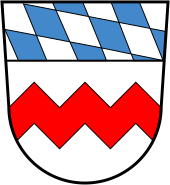
The zigzag bar is the allodic sign of the county of Scheyern, which can be traced in ducal seals from 1216 to around 1230, and which later appears in various colours in the coats of arms of sovereign monasteries. The Bavarian lozenge was not adopted by the Wittelsbach dynasty for their duchy of Bavaria until 1242 with the inheritance of the Counts of Bogen, a branch of the Babenberg dynasty. (The combination of both symbols is shown today in the coat of arms of the district of Dachau).
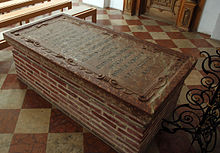
Collecting sarcophagus of the early Wittelsbach dynasty in Scheyern monastery
Questions and Answers
Q: Who is the Wittelsbach family?
A: The Wittelsbach family is a European royal family and a German dynasty from Bavaria.
Q: What were the members of the Wittelsbach family's roles in Bavaria?
A: Members of the Wittelsbach family were rulers of Bavaria, either as Dukes, Electors, or Kings, from 1180 until the revolution in 1918.
Q: When did the Wittelsbach family's reign in Bavaria end?
A: The Wittelsbach family's reign in Bavaria ended after the defeat of Germany in World War I in 1918.
Q: Did any other branches of the Wittelsbach family control other lands besides Bavaria?
A: Yes, other land was controlled by other branches of the family.
Q: What kind of rulership did the Wittelsbach family have in other lands they controlled?
A: The Wittelsbachs also ruled in other lands, although it is not clear from the text what kind of rulership they had in those places.
Q: Is the Wittelsbach family still influential in Germany today?
A: The text does not provide information about whether the Wittelsbach family continues to have influence in Germany today.
Q: Can you provide more information on the revolution that caused the end of the Wittelsbach family's reign?
A: The text does not provide detail on the nature or cause of the revolution that ended the Wittelsbach family's reign.
Search within the encyclopedia